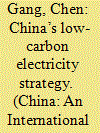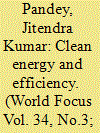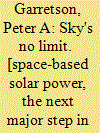|
|
|
Sort Order |
|
|
|
Items / Page
|
|
|
|
|
|
|
| Srl | Item |
| 1 |
ID:
162951


|
|
|
|
|
| Summary/Abstract |
The aim of this study is to assess the offshore wind and solar power and to determine whether the future power supply in Taiwan will be stable. The estimated annual offshore wind and solar power generation for 2030 are 11343 GWh and 11367 GWh, respectively. Based on these results, it appears that the annual power supply can easily help balance the total power demand. However, the power demand is high during the summer peak months, and power generation may be insufficient during peak summer hours by 2030. Specifically, in 2024, the peak hourly percent reserve margin (PRM) in summer will be negative (-0.9%). If the installation of offshore wind turbines and solar panels is delayed, then the problem of insufficiency will be even more severe. However, if the offshore wind and solar photovoltaic projects are completed on schedule, and the first, second, and third nuclear power plants (NPPs) extend their service to 2030, then the hourly PRM could reach 15% during the summer peak hours from 2025 to 2030 and 5–11% in the other years. Moreover, if the fourth NPP opens, then the estimated summer peak hourly PRM would increase by 6–7%.
|
|
|
|
|
|
|
|
|
|
|
|
|
|
|
|
| 2 |
ID:
176716


|
|
|
|
|
| Summary/Abstract |
This article contributes to the recent scholarly attempts towards bridging different energy studies perspectives in explaining the change of energy systems. Informed by political, socio-technical and techno-economic perspectives on energy transitions, we focus on explaining the divergent solar and wind power deployment rates across six Central and Eastern European countries. We suggest and test the proposition that the interplay of four key factors has shaped this development: state capacities, relations with Russia, technological lockin and electricity import dependency. We find that the countries relations towards Russia, the level of nuclear power lock-in and the state intervention in the energy sector have been instrumental in affecting the adoption of wind and solar power. The integrated framework and the findings presented in the article should encourage future energy transition research to capture and trace the interplay among different factors in an integrated and comparable manner.
|
|
|
|
|
|
|
|
|
|
|
|
|
|
|
|
| 3 |
ID:
146674


|
|
|
|
|
| Contents |
With a carbon-constrained new normal that emissions of greenhouse gases can no longer be assumed to be costless, non-fossil fuels including hydro, nuclear, wind and solar power have witnessed fast growth in both production and consumption in China. In promoting the production of different low-carbon alternatives, the Chinese government has been adjusting its policy prioritisation from time to time in targeted growth scopes, subsidy amount, on-grid tariffs and other financial incentives for various low-carbon power sectors. China’s Five-Year Plans have been playing a vital role in engendering fierce competition within the low-carbon energy sector. Other variables, like adjustment of electricity tariffs, inherent geographical and meteorological advantages related to certain types of power generation, domestic supporting industries, technological competitiveness and environmental concerns, have also helped to reshape the low-carbon power market.
|
|
|
|
|
|
|
|
|
|
|
|
|
|
|
|
| 4 |
ID:
118109


|
|
|
| 5 |
ID:
150650


|
|
|
|
|
| Summary/Abstract |
Photovoltaic (PV) Levelized Cost of Energy (LCOE) estimates are widely utilized by decision makers to predict the long-term cost and benefits of solar PV installations, but fail to consider local climate, which impacts PV panel lifetime and performance. Specific types of solar PV panels are known to respond to climate factors differently. Mono-, poly-, and amorphous-silicon (Si) PV technologies are known to exhibit varying degradation rates and instantaneous power losses as a function of operating temperature, humidity, thermal cycling, and panel soiling. We formulate an extended LCOE calculation, which considers PV module performance and lifespan as a function of local climate. The LCOE is then calculated for crystalline and amorphous Si PV technologies across several climates. Finally, we assess the impact of various policy incentives on reducing the firm's cost of solar deployment when controlling for climate. This assessment is the first to quantify tradeoffs between technologies, geographies, and policies in a unified manner. Results suggest crystalline Si solar panels as the most promising candidate for commercial-scale PV systems due to their low degradation rates compared to amorphous technologies. Across technologies, we note the strong ability of investment subsidies in removing uncertainty and reducing the LCOE, compared to production incentives.
|
|
|
|
|
|
|
|
|
|
|
|
|
|
|
|
| 6 |
ID:
110705


|
|
|
|
|
| Publication |
2011.
|
| Summary/Abstract |
Study of low-carbon and pollution renewable alternatives for China revealed that concentrating solar thermal (CST) electric power generation was underemphasized in China's renewable energy plan. The analysis shows the competitive viability of CST: (1) China has the key prerequisites to make CST power generation economical including high-quality insolation and appropriate land, (2) CST's proven history, scale, and dispatchability makes it a good utility-scale power option, especially in the economically underdeveloped Western regions, (3) while CST power is currently more expensive than coal-fired electricity on a nominal basis, when costs of externalities are accounted for, CST, at 11.4 US cents/kWh, can become 57% cheaper than scrubbed coal and 29% cheaper than nuclear power, (4) CST power continues dropping in cost due to economies of scale and technological improvements and can potentially realize a levelized electricity cost of around 4 cents/kWh within ten years, (5) it would significantly rise in competitiveness if and when China completes the extensive smart grid for connecting its solar-abundant western regions with the high-demand eastern regions, (6) CST has the potential to positively impact Western China's economy, but proper policy and deal structure must be in place to ensure that the local community shares the benefit.
|
|
|
|
|
|
|
|
|
|
|
|
|
|
|
|
| 7 |
ID:
069820


|
|
|
| 8 |
ID:
106908


|
|
|
|
|
| Publication |
2011.
|
| Summary/Abstract |
The high cost of launching payloads into orbit - roughly $20,000/kg - continues to deter large-scale exploration and exploitation of space. Ground-based launch systems may radically reduce costs to $200/kg, drastically altering the economics of spaceflight. Low costs will encourage the creation of new markets, including solar-based power satellites and disposal of nuclear waste. The US government should establish a goal of $200/kg by 2020 and provide the resources needed to develop such systems.
|
|
|
|
|
|
|
|
|
|
|
|
|
|
|
|
| 9 |
ID:
181770


|
|
|
|
|
| Summary/Abstract |
Auctions have become the primary instrument for promoting renewable energy around the world. However, the data published on such auctions are typically limited to aggregated information (e.g., total awarded capacity, average payments). These data constraints hinder the evaluation of realisation rates and other relevant auction dynamics. In this study, we present an algorithm to overcome these data limitations in German renewable energy auction programme by combining publicly available information from four different databases. We apply it to the German solar auction programme and evaluate auctions using quantitative methods. We calculate realisation rates and—using correlation and regression analysis—explore the impact of PV module prices, competition, and project and developer characteristics on project realisation and bid values. Our results confirm that the German auctions were effective. We also found that project realisation took, on average, 1.5 years (with 28% of projects finished late and incurring a financial penalty), nearly half of projects changed location before completion (again, incurring a financial penalty) and small and inexperienced developers could successfully participate in auctions.
|
|
|
|
|
|
|
|
|
|
|
|
|
|
|
|
| 10 |
ID:
133043


|
|
|
|
|
| Publication |
2014.
|
| Summary/Abstract |
We have calculated annual (i.e., for each day of the year) daytime dependences of the electric power output per unit area of an a-Si:H solar cell (SC) at latitudes 45°N, 50°N, 55°N, 60°N and at certain geographical points of Russia, Kazakhstan, Ukraine and Belarus. The calculations were based on a rigorous theoretical model, which allows to determine photoconversion efficiency, optimal electric power output and other photovoltaic electrical characteristics at arbitrary angles of solar irradiance incidence on an a-Si:H-based SC. Parameters of the a-Si:H SC under consideration provide photoconversion efficiency of 10% at 12:00 noon on equinox day at the 45°N latitude despite small total thickness of 0.7 µm of the a-Si:H SC structure up to the rear contact. Normalization of the obtained results by maximal values enables one to infer respective time dependencies for other types of SCs. In combination with the data on average numbers of sunny days per year (or average annual sunshine hours) for certain geographical regions, this provides a way for understanding the feasibility of solar electricity generation in these regions. Based on this study, we identify regions of Russia, Kazakhstan and Ukraine, for which electricity generation exceeds the average values by over 30%.
|
|
|
|
|
|
|
|
|
|
|
|
|
|
|
|
| 11 |
ID:
153173


|
|
|
|
|
| Publication |
London, Elsevier, 2014.
|
| Description |
xi, 376p.pbk
|
| Standard Number |
9780128010273
|
|
|
|
|
|
|
|
|
|
|
|
Copies: C:1/I:0,R:0,Q:0
Circulation
| Accession# | Call# | Current Location | Status | Policy | Location |
| 059079 | 333.79/TOW 059079 | Main | On Shelf | General | |
|
|
|
|
| 12 |
ID:
132684


|
|
|
|
|
| Publication |
2014.
|
| Summary/Abstract |
The Jawaharlal Nehru National Solar Mission (JNNSM), India×s flagship policy for solar energy deployment, includes an increasingly strict Domestic Content Requirement (DCR) intended to promote the domestic crystalline photovoltaic solar industry. We examine the impact of the JNNSM DCR on the utilization of domestic and domestic crystalline silicon modules. Using a plant-level database of approximately 250 plants, we show that the first, and weaker, version of the policy accomplished its intention of promoting domestic crystalline silicon modules. However, the second, and stricter, version of the policy has not been as effective: it appears to have promoted the use of foreign thin film modules instead. This analysis shows that the tightening of the DCR was associated with leakage to foreign thin film modules. This suggests that DCR policies need to be comprehensive in scope to ensure that they achieve a goal of using only domestic content; however, policymakers should appropriately assess the welfare impacts of such restrictions.
|
|
|
|
|
|
|
|
|
|
|
|
|
|
|
|
| 13 |
ID:
092732


|
|
|
|
|
| Publication |
2009.
|
| Summary/Abstract |
In this paper all provinces of South Africa with a good potential for the implementation of large-scale concentrating solar power plants are identified using geographic information systems. The areas are assumed suitable if they get sufficient sunshine, are close enough to transmission lines, are flat enough, their respective vegetation is not under threat and they have a suitable land use profile. Various maps are created showing the solar resource, the slope, areas with "least threatened" vegetation, proximity to transmission lines and areas suitable for the installation of large concentrating solar power plants. Assuming the installation of parabolic trough plants, it is found that the identified suitable areas could accommodate plants with a nominal capacity of 510.3 GW in the Northern Cape, 25.3 GW in the Free State, 10.5 GW in the Western Cape and 1.6 GW in the Eastern Cape, which gives a total potential nominal capacity of 547.6 GW for the whole country.
|
|
|
|
|
|
|
|
|
|
|
|
|
|
|
|
| 14 |
ID:
119790


|
|
|
|
|
| Publication |
2013.
|
| Summary/Abstract |
New solar Photovoltaic (PV) installations have grown globally at a rapid pace in recent years. We provide a comprehensive assessment of the cost competitiveness of this electric power source. Based on data available for the second half of 2011, we conclude that utility-scale PV installations are not yet cost competitive with fossil fuel power plants. In contrast, commercial-scale installations have already attained cost parity in the sense that the generating cost of power from solar PV is comparable to the retail electricity prices that commercial users pay, at least in certain parts of the U.S. This conclusion is shown to depend crucially on both the current federal tax subsidies for solar power and an ideal geographic location for the solar installation. Projecting recent industry trends into the future, we estimate that utility-scale solar PV facilities are on track to become cost competitive by the end of this decade. Furthermore, commercial-scale installations could reach "grid parity" in about ten years, if the current federal tax incentives for solar power were to expire at that point.
|
|
|
|
|
|
|
|
|
|
|
|
|
|
|
|
| 15 |
ID:
103374


|
|
|
|
|
| Publication |
2011.
|
| Summary/Abstract |
Climate change, pollution, and energy insecurity are among the greatest problems of our time. Addressing them requires major changes in our energy infrastructure. Here, we analyze the feasibility of providing worldwide energy for all purposes (electric power, transportation, heating/cooling, etc.) from wind, water, and sunlight (WWS). In Part I, we discuss WWS energy system characteristics, current and future energy demand, availability of WWS resources, numbers of WWS devices, and area and material requirements. In Part II, we address variability, economics, and policy of WWS energy. We estimate that 3,800,000 5 MW wind turbines, 49,000 300 MW concentrated solar plants, 40,000 300 MW solar PV power plants, 1.7 billion 3 kW rooftop PV systems, 5350 100 MW geothermal power plants, 270 new 1300 MW hydroelectric power plants, 720,000 0.75 MW wave devices, and 490,000 1 MW tidal turbines can power a 2030 WWS world that uses electricity and electrolytic hydrogen for all purposes. Such a WWS infrastructure reduces world power demand by 30% and requires only 0.41% and 0.59% more of the world's land for footprint and spacing, respectively. We suggest producing all new energy with WWS by 2030 and replacing the pre-existing energy by 2050. Barriers to the plan are primarily social and political, not technological or economic. The energy cost in a WWS world should be similar to that today.
|
|
|
|
|
|
|
|
|
|
|
|
|
|
|
|
| 16 |
ID:
103375


|
|
|
|
|
| Publication |
2011.
|
| Summary/Abstract |
This is Part II of two papers evaluating the feasibility of providing all energy for all purposes (electric power, transportation, and heating/cooling), everywhere in the world, from wind, water, and the sun (WWS). In Part I, we described the prominent renewable energy plans that have been proposed and discussed the characteristics of WWS energy systems, the global demand for and availability of WWS energy, quantities and areas required for WWS infrastructure, and supplies of critical materials. Here, we discuss methods of addressing the variability of WWS energy to ensure that power supply reliably matches demand (including interconnecting geographically dispersed resources, using hydroelectricity, using demand-response management, storing electric power on site, over-sizing peak generation capacity and producing hydrogen with the excess, storing electric power in vehicle batteries, and forecasting weather to project energy supplies), the economics of WWS generation and transmission, the economics of WWS use in transportation, and policy measures needed to enhance the viability of a WWS system. We find that the cost of energy in a 100% WWS will be similar to the cost today. We conclude that barriers to a 100% conversion to WWS power worldwide are primarily social and political, not technological or even economic.
|
|
|
|
|
|
|
|
|
|
|
|
|
|
|
|
| 17 |
ID:
112331


|
|
|
| 18 |
ID:
124350


|
|
|
|
|
| Publication |
2013.
|
| Summary/Abstract |
While emergy analysis (i.e. emergy synthesis, environmental accounting) was developed in the early 1980s by H.T. Odum, building upon his seminal work outlining the energy basis for man and nature, the method is still developing. Some very important aspects of the method, such as the global baseline for renewable emergy and how the emergy yield ratio (EYR), a critical index for implicating the contribution of a process to society, is to be calculated are still under debate in the scientific community. This makes it all the more critical that when an emergy analysis is done all methodology is laid bare and justified. Unfortunately, Zhang et al. (2012. Energy Policy 42, pp 232-238) is deficient in doing so. In the response below I lay out the problems I observed in the paper and propose a revision to their analysis. I should note that no issues were found with the embodied energy portion of the analysis and the inconsistencies with accepted methodology were likely due to an unfamiliarity with the emergy method.
|
|
|
|
|
|
|
|
|
|
|
|
|
|
|
|
| 19 |
ID:
166558


|
|
|
|
|
| Summary/Abstract |
As new renewable energy applications, building-integrated photovoltaics (BIPV) systems have significant potential to facilitate energy transitions towards renewable energy in highly urbanized countries, where large areas of land for developing large-scale solar or wind farms are limited. Government policy plays a significant role in nurturing and protecting energy innovations at the early development stage, such as BIPV. However, various actors could have divergent views on the policies for energy innovations, and policymakers need to consider these views in policymaking to avoid potential failures in policy implementation. By taking BIPV as an example, this study aims to reveal stakeholders' different perspectives on the required innovation policies for new energy technologies based on Q methodology. The results indicate even though stakeholders share similar views on some aspects of BIPV policies, four significantly distinct policy perspectives on BIPV exist in stakeholders' mindsets, including supervisory support, intensively investigate, cautiously stimulate and proactively promote. These policy perspectives require significantly different approaches to promote BIPV, which indicates the complexity in formulating one set of policy mix catering for the various mindsets of stakeholders. This study has both theoretical contributions to innovation policy mix for energy transitions, and policy implications for promoting energy innovations, especially BIPV worldwide.
|
|
|
|
|
|
|
|
|
|
|
|
|
|
|
|
| 20 |
ID:
099429


|
|
|
|
|
| Publication |
New Delhi, IDSA, 2010.
|
| Description |
172p.
|
| Series |
IDSA occasional paper no. 9
|
| Standard Number |
9788186019719
|
|
|
|
|
|
|
|
|
|
|
|
Copies: C:2/I:0,R:0,Q:0
Circulation
| Accession# | Call# | Current Location | Status | Policy | Location |
| 055325 | 333.7923/GAR 055325 | Main | On Shelf | General | |
| 055326 | 333.7923/GAR 055326 | Main | On Shelf | General | |
|
|
|
|
|
|
|
|
|